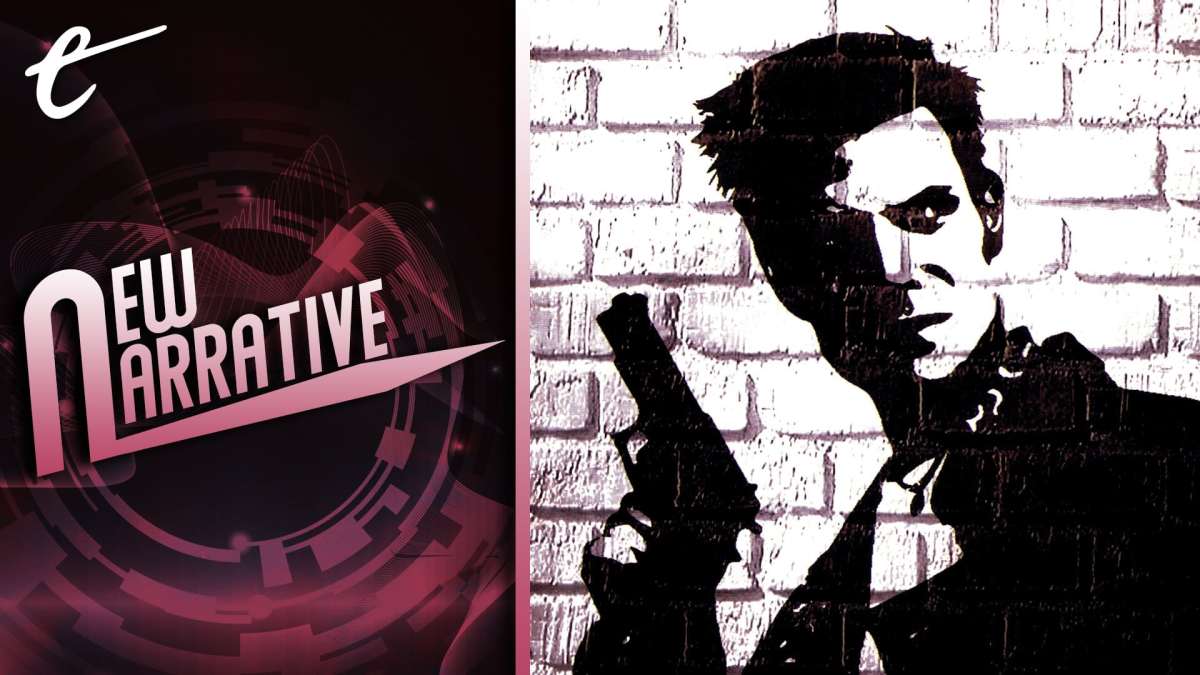Max Payne will celebrate its 20th anniversary next month. Going back to it now, particularly in light of its sequels and legacy, feels like picking up a piece of the industry preserved in amber. There is a strange brew of youthful naivety and borderline sociopathy in a narrative replete with tropes and clichés, while the gameplay trades on the cultural zeitgeist established by The Matrix two years earlier. And yet it remains one of the most impressive sophomore efforts from a young studio and one of the standout games from the era.
Max Payne is a self-proclaimed “man with nothing to lose,” a young New York ex-cop who deliberately takes a dangerous undercover assignment with the Drug Enforcement Agency after his wife and baby are murdered by junkies high on a new drug. The assignment leads him on a bloody climb through the hierarchy of New York’s mobster families, narrated with pitch-perfect sourness by James McCaffrey and delivered through a mix of graphic novel-style panels, in-engine cutscenes, and gameplay voice-over.
The narration is so heavy with purple prose that it’s unclear whether to treat it as a parody of hard-boiled crime and noir fiction or an overly earnest attempt to be part of that canon. Either way, it’s an excuse for some of the most joyfully ridiculous metaphors and one-liners ever committed to a video game script – numerous puns on Max’s preposterous name, for example, or the deadpan delivery of phrases as absurd as, “I don’t know about angels, but it’s fear that gives men wings.”

The story is a greatest hits of crime and noir staples, from the maverick cop archetype of Inspector “Tequila” Yuen in John Woo’s Hard Boiled, to the double and triple crosses seen in Raymond Chandler’s The Big Sleep (both sources that Max explicitly references in his monologues). Films of the era had popularized nonlinear storytelling, including Pulp Fiction, Fight Club, and Memento, and Max Payne starts with the ending, more or less completely stripped of context for maximum dramatic effect. There is a “mandatory” capture-and-escape level seen previously in Half-Life, Deus Ex, and others. There are evil mobsters with unconvincing Jersey accents that could have been extras in The Sopranos. There is even an all-encompassing conspiracy that ultimately gives a motive for the killing of Max’s family and paints a target for his revenge.
In short, despite every effort to stay gritty and grounded, it is willfully over the top. You can feel the youthful enthusiasm and exuberance of a crime and noir fiction enthusiast. There is a hint of it in Max’s violently scrunched up eyebrows or his cynical half-smile, which were based on photographs of writer Sam Lake’s face. You can almost see it in the way Max is animated to jog lightly down corridors and snowy alleyways, leather jacket billowing open behind him despite the worst blizzard in the city’s history.
The enthusiasm spills over into the gameplay. While ostensibly a typical third-person action shooter with an arsenal of single and dual-wielded pistols, rifles, grenades, and other destructive paraphernalia, Max Payne set itself apart from its contemporaries with a bullet time mechanic. With the tap of a button, you can shoot goons in slow motion or execute a slow-motion dive in any direction while shooting. Crucially, aiming is still done in real time, which provides an important tactical advantage in some of the more intense firefights.

The gun fu cinema of the late ‘80s and ‘90s is the real influence here. However, Max Payne drew obvious comparisons with The Matrix with the game’s individually modeled bullets and bullet trails, cinematic slow-motion kills, and a Pause menu camera that could capture Max mid-dive and then slowly rotate around him. The Matrix quickly became a global cultural phenomenon upon its release in 1999, so it was natural to assume that 2001’s Max Payne was trying to capitalize on its influence.
In fact, Max Payne had been in development at Remedy Entertainment since 1996. It was the studio’s second title and its first foray into 3D. There is something of Max’s youthful abandon and aggressive enthusiasm in the way Remedy managed to deliver cutting-edge photo-referenced textures, particle effects, and animations. As a result, Max Payne established the studio as a purveyor of technically impressive third-person titles: Alan Wake and Quantum Break were a showcase for successive generations of Xbox hardware, while Control was one of the first games to fully utilize ray tracing.
Max Payne has also left a broader legacy. The bullet time mechanic has found its way into countless subsequent games and mods. There is a sense of irony to see it in 2003’s Enter the Matrix, for example, or in 2007’s Stranglehold, John Woo’s video game sequel to the Hard Boiled film. But it also appears in more recent titles, like the excellent My Friend Pedro and the less excellent Biomutant.
Meanwhile, the franchise itself received two sequels before going on hiatus. Max Payne 2 did not stray far from the mood and tropes of the original, picking up many plot points, characters, and themes. Max Payne 3, on the other hand – handed over to Rockstar Studios and written by a team headed by Grand Theft Auto’s Dan Houser – felt like a deliberate subversion of these tropes.

By the third installment, Max is years older, struggling with substance abuse, and working a job in Brazil as private security for a wealthy family. He has none of the swagger or energy of 2001’s Max and none of that hidden enthusiasm. He is broken, cynical, borderline nihilistic, quipping to shield himself from the outside world rather than to pass commentary on it – “Need a hand? No, do you?” is a common refrain throughout the game. There is another conspiracy, but unlike with the secret society from the first two games, it’s a personal betrayal that Max is too drunk, disengaged, and out of touch with local politics to notice.
While Max Payne 3 was criticized for its depiction of Brazil and for abandoning the silliness of the originals, its implicit deconstruction of the first game suggests a recognition that some narrative elements have not aged well. How comfortable are we to play as a sociopathic ex-cop on a vigilante killing spree with little accountability or restraint? Granted, the police do try to apprehend Max throughout most of Max Payne, but the narrative does its best to portray them as short-sighted, cantankerous, and ultimately just another obstacle on Max’s way to justice. In comparison, while Max is still mowing down hundreds of thugs in Max Payne 3, there is no sense that he is fixing anything by doing so. Every gunfight brings new problems, loosening his grip on a situation he already barely has a grasp of.
Which brings me back to my original point: Max Payne at 20 years old is a curiously preserved piece of the industry. You can feel the earnest enthusiasm of a young studio flexing to release something technologically and narratively complex in an expanding entertainment medium, and that enthusiasm translates to gameplay that still often feels well-paced and satisfying. But you can equally see the growing pains in mechanics and narrative beats that are very much of their time and probably best left there. Still, if Max ever comes back for a fourth round, I doubt I will be able to resist yet another replay of the original.






Published: Jun 30, 2021 11:00 am